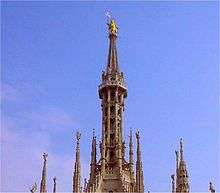Oh mia bela Madunina
| "Oh mia bela Madunina" | |
|---|---|
 The Madonnina | |
| Song | |
| English title | My beautiful Madonnina |
| Written | 1934 |
| Writer(s) | Giovanni d'Anzi |
| Language | Milanese dialect of Lombard |
"Oh mia bèla Madunina" (Classical Milanese orthography: Oh mia bella Madonnina [o ˌmi.a ˈbɛla maduˈniːna]; "Oh my beautiful little Madonna" in Milanese) is a song by Giovanni D'Anzi which is an unofficial city anthem of Milan.[1] The title refers to the golden statue of the Virgin Mary on the spire of Milan Cathedral visible all over the city, namely the Madonnina (Madunina in the Milanese dialect).
The song was written and composed in 1934 by the Milan songwriter Giovanni D'Anzi (1906–1974). In the 1930s, many immigrants from the Mezzogiorno, especially from the region of Naples, came to Milan bringing with them their famous Neapolitan songs such as "’O sole mio". D'Anzi thus decided to create a musical answer from Milan. The song became a hit in the city almost immediately, and in 1938 it topped the Italian hit parade.
Musically, "Oh mia bela Madunina" has similarities to American ballads of the time.[2] The lyrics give some praise to Neapolitan music but add that Milan also deserves a mention; they address the Madonna under whose domination Milan is vibrant with life and always busy (a pointed reference to the reputation of the Southerners whom the Milanese regarded as lazy). The lyrics end with an offer to shake hands because it is a small world, after all, but the closing verse ma Milan, l'è on gran Milan! ("but Milan is a great Milan!") reaffirms the Milanese pride. It's often sung by AC Milan and Inter Milan fans during the matches, in particular during the Derby della Madonnina.
Original lyrics
A disen la canzon la nass a Napoli,
e certament gh'hann minga tucc i tòrt.
Surriento, Mergellina, tucc i pòpoli
j'avrann cantaa almen on milion de vòlt.
Mi speri che s'offenderà nissun
se parlom on ciccin anca de nun…
[chorus:]
Oh mia bella Madonnina,
che te brillet de lontan,
tutta d'òra e piscinina,
ti te dòminet Milan;
sòtt'a ti se viv la vita,
se sta mai coi man in man.
Canten tucc "lontan de Napoli se moeur",
ma poeu vegnen chì a Milan!
Adess gh'è la canzon de Ròma magica,
de Nina, er Cupolone, Rugantin;
se sbatten in del Tever, ròba tragica,
esageren, me par, on ciccinin.
Speremm che vegna minga la mania
de mettes a cantà "Malano mia!"
[chorus:]
Oh mia bella Madonnina,
che te brillet de lontan,
tutta d'òra e piscinina,
ti te dòminet Milan;
sì, vegnii senza paura,
nun ve slongaremm la man!
Tutt el mond a l'è paes, e semm d'accòrd,
ma Milan, l'è on gran Milan!
English translation
They say that songs were born in Naples,
and they certainly aren't entirely wrong.
Sorrento, Mergellina, every people
must have sung about them at least a million times.
I hope it won't offend anybody
if we talk a little about ourselves…
[chorus:]
Oh my beautiful Madonnina,
who shine from far away,
all golden and minute,
you dominate Milan;
at your feet life is lived,
there's no twiddling of one's thumbs.
Everybody sings "away from Naples one dies",
but then they come to Milan.
Now there this song about "magic Rome",
about Nina, St. Peter's Basilica's dome[note 1] and Rugantino,
about people throwing themselves in the Tiber – tragic stories,
perhaps a little over the top?
I hope the next craze won't be
singing "Malano mia!"[note 2]
[chorus:]
Oh my beautiful Madonnina,
who shine from far away,
all golden and minute,
you dominate Milan;
so, come, have no fear,
we'll extend to you our hand,
the whole world is but a village, and we agree,
but Milan's a great Milan.
Footnotes
- ↑ Informally called er Cupolone ("the large dome") by the Romans.
- ↑ Neapolitan for "Oh my Milan".
References
- ↑ M. Ridolfi. Almanacco della Repubblica: storia d'Italia attraverso le tradizioni, le istituzioni e le simbologie repubblicane. p. 157.
- ↑ E. Guaitamacchi (2009). Mille canzoni che ci hanno cambiato la vita. Rizzoli. ISBN 9788817033923. Retrieved 2015-04-30.
Sources
- Giovanni D'Anzi, Le canzoni milanesi, Curci, Milano 1961